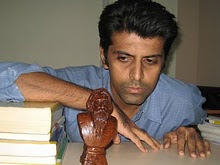This is based on
this post at mathoverflow:
The basic question was how to 'hide' a unit cube which is a source of light with opaque copies of itself such that no light reaches infinity. As was not clear to me when the question was raised, this hiding can be attempted at multiple levels. Let us come down to 2D and try to hide a square.
(1) by fixing 4 opaque squares flush with the faces of the light source square. In this case, vertices of the glowing square can emit light that does reaches infinity but what is visible from infinity are only points, no 1-D subset of the square. Here, if one considers the *total outer boundary of the total layout of 5 squares*, the glowing square has a finite intersection with this boundary - the 4 vertices.
(2) as given on this
earlier post here (second figure). Here, we hide the glowing yellow squrare with 5 opaque copies (unshaded). In this case, as pointed out by Erich Friedman, rays can possibly squeeze between opaque squares touching each other but unlike (1), the outer boundary of the total layout has no intersection at all with the glowing square. But yes, there can be rays from the glowing square that need only to pass thru just 1 point on the opaque cordon to get to infintiy.
(3) a still more 'secure' cordon with 6 opaque squares given by Prof. Friedman himself in https://mathoverflow.net/questions/468850/how-many-unit-cubes-are-needed-to-hide-a-unit-cube-fully-in-3d . Difference between this and (2) is that any ray from the glowing square has necessarily to pass thru at some
interior points of the opaque squares to get to infinity.
IMO, (2) and (3) are both nontrivial with (3) more so. Going to 3D, things can get a lot more interesting.
___
Note: problem 7 of section 2.7 in Research Problems in Discrete Geometry by Moser et al refers to every ray emerging from the glowing body meeting
either the interior or boundary of the opaque copies. Here, we have separated the question into 2.
_______
And a different direction: to hide more than one unit square with opaque unit squares - begin with 2!
